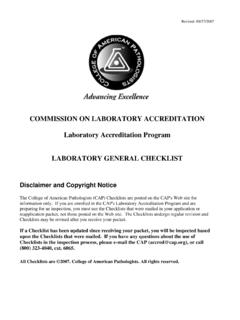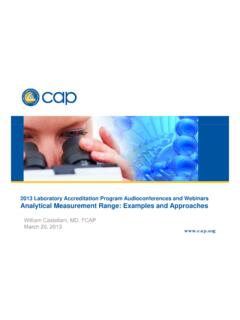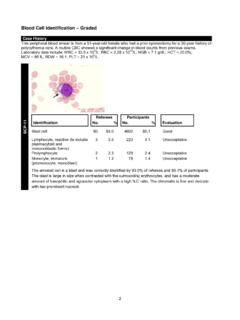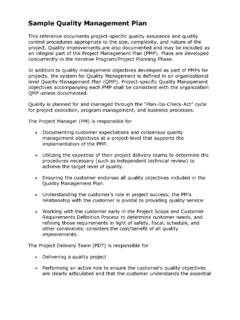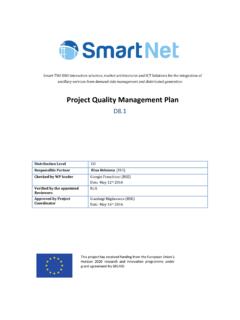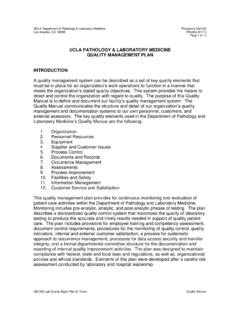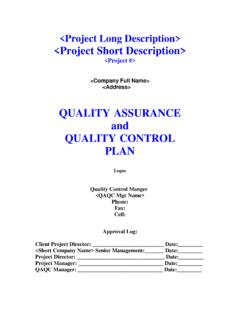Transcription of The Laboratory Quality Management Plan - webapps.cap.org
1 The Laboratory Quality Management Plan167 Chapter 7 The Laboratory Quality Management PlanThis final chapter provides guidance in preparing and implementing a Quality managementplan. Sample plans from three laboratories are included, and readers should feel free to excerptfrom these examples when developing plans for their own CAP Laboratory Accreditation Program requires laboratories to maintain a writtenplan that describes the overall Quality Management program of the 2004, of laboratories inspected by the CAP were cited for not having an adequate qualitymanagement Quality Management plan spells out the specific steps that a Laboratory will take toensure that Quality is being maintained. A well-constructed plan will be informed by materialin the previous chapters of this manual case studies of Quality failure, approaches to qualitymanagement, regulatory and accreditation requirements, particular Laboratory risks and controlmeasures, and feedback from customers and this manual we have emphasized that Laboratory Quality and safety failuresmay result from diverse causes, ranging from poor communication to human error and frominstrument failure to fraud.
2 The Laboratory director must ultimately choose which particularquality and safety hazards a Laboratory will address, and the controls that will be used tomitigate each hazard. The Laboratory s Quality Management plan brings these decisions togetherin a document that spells out the approach to managing Quality and patient safety that will beused in a particular organization. PurposeThe purpose of the Quality Management plan is to describe the Laboratory s approach to themanagement of Quality and patient safety. A properly documented and implemented planwill provide reasonable assurance that the Laboratory (1) meets defined standards of qualitypractice, (2) is in compliance with applicable laws and regulations related to Quality andpatient safety, and (3) is engaged in credible Quality improvement activities. A clinicallaboratory s Quality Management plan will be of interest to Laboratory owners, laboratoryusers, external inspectors, and, potentially, to people have unrealistic expectations of what a Quality Management plan canaccomplish.
3 They believe a plan can absolutely ensure the Quality of every laboratoryoperation, guarantee the accuracy of every Laboratory report, and ensure complete andcontinuous compliance with laws and regulations. However, the Quality Management planis primarily a system of controls, and all control systems have inherent limitations. Controlsystems rely on judgments that may be faulty. Controls may be upset by breakdowns thatoccur despite the existence of protective systems. Controls can be circumvented by collusionbetween several individuals or by managers who choose to override control systems. Finally,the design of any internal control system reflects resource constraints; controls will only beimplemented when their benefits are likely to exceed their costs. Therefore, a quality168 The Laboratory Quality Management PlanChapter 7management plan can provide only reasonable assurance that the Laboratory substantiallyconforms to standards.
4 It is not a Quality Management plan must be formally approved by the Laboratory director on anannual approval is normally evidenced by a signature. By approving a qualityplan, the Laboratory director signifies that the activities described in the plan if faithfullyexecuted will reasonably ensure that the Laboratory meets applicable Quality and patientsafety standards and is committed to a program of Quality improvement. If the director knowsof substantial Quality deviations in Laboratory operations that will not be detected or addressedby a Quality plan , the director should not approve the organizations require that individuals besides the Laboratory director approve thequality plan . Other individuals may approve Quality plans, but the Laboratory director mustalso approve the plan to satisfy regulatory requirements. In 2004, of laboratoriesinspected by the CAP were cited because the Quality Management program had not beenreviewed for effectiveness during the previous to Other Institutional Quality ProgramsIn small stand-alone clinical laboratories, the Laboratory Quality plan usually exists on its hospital-based laboratories, the Laboratory Quality plan may include a section that specifiesinformation that is to be reported to a higher-level authority, such as an institution-widequality committee.
5 In very large operations, each section of the Laboratory (eg, chemistry,anatomic pathology) may have its own Quality plan , and the implementation of the plan willgenerate reports to a Laboratory -wide Quality officer or committee. In multi-site operations,each testing site may have its own Quality plan . The organizational level at which Quality plansare developed depends on the size and complexity of the Laboratory and the nature of itscorporate ElementsWhat should be included in a Quality plan ? Certain elements are required by major accreditingagencies,276and we believe every plan should include several additional elements that havebeen identified by the accounting profession as important components of Management recommend the following elements be considered for inclusion in every qualitymanagement Commitment to Quality and Patient SafetyQuality and patient safety flourish in laboratories with the proper tone.
6 This tone includesan acceptance of standards, controls, discipline, structure, and responsibility. Managementshould demonstrate that Quality control and patient safety are taken seriously and create aThe Laboratory Quality Management Plan169 Chapter 7work environment in which employees are encouraged to discuss Quality and safety concernswithout fear of retribution. A statement to this effect within the Laboratory Quality plan helpsset the proper tone, although words alone are never AssessmentThe Quality Management plan should identify significant risks to Quality and patient safetythat could impact Laboratory operations. To some extent, CLIA regulations and the CAPL aboratory Accreditation Program have already done 90% of the work required to identifyrisks. The CAP LAP checklists (which incorporate relevant CLIA regulations) spell outhundreds of problems that can interfere with the Quality of Laboratory operations, particularlyin the analytic phase of testing.
7 These risks have been identified by experts in laboratorymedicine who are also familiar with the practical challenges of running a clinical Laboratory director participating in the CAP accreditation program need only beconcerned with the remaining 10% risks that are unique to the director s organization orwhich local circumstances suggest require greater attention. In spelling out special local risksto Quality and safety, we suggest that authors of Quality Management plans focus on(1) institutional priorities (perhaps the director s institution has identified cancer care or heartdisease as a priority), (2) known problems with Laboratory operations, (3) customer feedback,and (4) recurring incidents or sentinel events. We believe the risk of fraud and malfeasance,while small, needs to be addressed in a plan , and we suggest examples of how this risk canbe mitigated in one of our sample plans.
8 There is a regulatory requirement that the qualitymanagement plan must cover all aspects of a Laboratory s scope of care, such as inpatientand outpatient services, reference Laboratory services, satellite and point-of-care testing, andconsultative services. Therefore, risks should be identified for each area of service. There isalso a regulatory requirement that the Quality Management plan include all sections of thelaboratory and all shifts of some institutions, a Quality Management plan contains a section called Quality Planning,which includes the risk assessment activities discussed above as well as organized research intocustomers needs and the development of products and services that meet those ActivitiesControl activities (sometimes called Quality Laboratory Practices) are the policies, processes,procedures, and inventions that mitigate risks. For every significant risk, one or more controlactivities should be in place.
9 Control activities can take a variety of forms. For example, therisk of receiving a bad lot of reagents is mitigated by a procedure to test each new lot ofreagents before placing the lot into service (as well as other controls). The risk of someonemisappropriating private health information is mitigated by the requirement that passwords beused to access Laboratory computer systems (as well as other controls). Most control measuresare spelled out in individual procedures; there is no need to repeat in the plan every controlactivity that is already described elsewhere. When not specified in other documents, thequality Management plan should include a description of the control activities that thelaboratory will follow to address a particular hazard. Controls applied to broad laboratoryissues, such as turnaround time or specimen collection, often are described in qualitymanagement Laboratory Quality Management PlanChapter 7 Information and CommunicationIf not described in other procedures, the Quality Management plan should specify how qualityand safety information is to be collected and disseminated.
10 This is particularly important forquality monitors that bridge traditional organizational boundaries. The frequency of datacollection, sources of information, and any calculations should be specified in the plan or aseparate procedure. If each section of a Laboratory has its own Quality plan , the informationthat will be sent upstream to the Laboratory director or Laboratory -wide Quality committeeshould be specified. It may also be necessary to provide instructions for communicating withan institution-wide Quality committee and with suppliers or customers who are to receivereports from the control systems need to be monitored; that is, the performance of laboratoryoperations over time and the internal control system itself need to be periodically least three types of monitoring are performed and should be spelled out in a qualitymanagement plan : First, complaints, incidents, and sentinel events should be reviewed.
